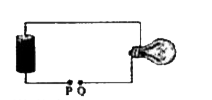Which of these liquids will light up an LED connected in a tester circuit?
Honey
Vinegar
Milk
Oil
The correct Answer is:B
To determine which of the given liquids will light up an LED connected in a tester circuit, we need to analyze the properties of the liquids in question. Here's a step-by-step solution:
Step 1: Understand the Tester Circuit
A tester circuit consists of a container filled with a liquid and two conductive rods dipped into that liquid. The circuit is completed when the liquid allows electric current to flow between the rods, lighting up the LED.
Hint: Remember that for the LED to light up, the circuit must be complete, meaning current must flow through the liquid.
Step 2: Identify the Requirement for Current Flow
For current to flow through the liquid, it must contain charged particles (ions). These ions can be either cations (positively charged) or anions (negatively charged). Liquids that can dissociate into ions when dissolved in water are called electrolytes.
Hint: Think about what types of liquids can conduct electricity. What do they need to have?
Step 3: Analyze the Given Liquids
Let’s consider the options:
1. Vinegar (Acetic Acid): This is an acid that dissociates into acetate ions (CH3COO-) and hydrogen ions (H+), making it an electrolyte.
2. Honey: Honey is a viscous liquid that does not dissociate into ions and is not a good conductor of electricity.
3. Milk: While milk contains some ions, it is not a strong electrolyte and does not conduct electricity well enough to light an LED.
4. Oil: Oil is a non-polar substance and does not conduct electricity as it does not contain ions.
Hint: Consider which of these liquids can break down into ions when an electric current is applied.
Step 4: Conclusion
Among the given options, only vinegar (acetic acid) can dissociate into ions and allow electric current to flow. Therefore, it is the only liquid that will light up the LED in the tester circuit.
Final Answer: The liquid that will light up the LED is Vinegar (Acetic Acid).
A tester circuit consists of a container filled with a liquid and two conductive rods dipped into that liquid. The circuit is completed when the liquid allows electric current to flow between the rods, lighting up the LED.
For current to flow through the liquid, it must contain charged particles (ions). These ions can be either cations (positively charged) or anions (negatively charged). Liquids that can dissociate into ions when dissolved in water are called electrolytes.
Let’s consider the options:
1. Vinegar (Acetic Acid): This is an acid that dissociates into acetate ions (CH3COO-) and hydrogen ions (H+), making it an electrolyte.
2. Honey: Honey is a viscous liquid that does not dissociate into ions and is not a good conductor of electricity.
3. Milk: While milk contains some ions, it is not a strong electrolyte and does not conduct electricity well enough to light an LED.
4. Oil: Oil is a non-polar substance and does not conduct electricity as it does not contain ions.
Among the given options, only vinegar (acetic acid) can dissociate into ions and allow electric current to flow. Therefore, it is the only liquid that will light up the LED in the tester circuit.
Topper's Solved these Questions
- BOOK - PEARSON IIT JEE FOUNDATIONCHAPTER - CHEMICAL EFFECTS OF ELECTRIC CURRENTEXERCISE - CLASSROOM CORNER (COMPREHENSION-BASED QUESTIONS)5videos
CHEMICAL EFFECTS OF ELECTRIC CURRENT
- BOOK - PEARSON IIT JEE FOUNDATIONCHAPTER - CHEMICAL EFFECTS OF ELECTRIC CURRENTEXERCISE - CLASSROOM CORNER (SUBJECTIVE TYPE QUESTIONS)13videos
CHEMICAL EFFECTS OF ELECTRIC CURRENT
- BOOK - PEARSON IIT JEE FOUNDATIONCHAPTER - CHEMICAL EFFECTS OF ELECTRIC CURRENTEXERCISE - HOTS10videos
CHEMICAL EFFECTS OF ELECTRIC CURRENT
- BOOK - PEARSON IIT JEE FOUNDATIONCHAPTER - KINEMATICSEXERCISE - LEVEL 318videos
KINEMATICS
- BOOK - PEARSON IIT JEE FOUNDATIONCHAPTER - DYNAMICSEXERCISE - CONCEPT APPLICATION(LEVEL 3)15videos
DYNAMICS
Similar Questions
Knowledge Check
- Question 1 - Select One
Amrita is trying to set-up an electric circuit. She runs short of connecting wires. Which of the following materials can she use to complete the circuit ?
ARubber pipeBThick threadCSteel wireDGlass rod - Question 2 - Select One
Liquid flow from a higher to a level .Which of the following liquids can climb up the wall of the glass vessel in which it is placed ?
AAlcoholBLiquid HeCLiquidN2Dwater
Which instrument is used to measure current in the circuit ? how is it connected in the circuit?
View SolutionTo which wire do you connect fuse wire in a house hold circuit?
View SolutionTommy sets up an electrical circuit as shown in the figure. He connects points P and Q with different materials.

The bulb will light up when points P and Q are connected by a plate made ofView SolutionTommy sets up an electrical circuit as shown in the figure. He connects points P and Q with different materials.

The bulb will light up when points P and Q are connected by a plate made ofView SolutionBrad sets up an electrical circuit as shown in the given figure. He connects points P and Q of the circuit with four different rods made of four different materials - glass, wood, copper, and asbestos.

The bulb in the circuit will not light up when points P and Q are connected withView SolutionBrad sets up an electrical circuit as shown in the figure. He connects points P and Q of the circuit with four different rods made of four different materials - glass, wood, copper, and asbestos.

The bulb in the circuit will not light up when points P and Q are connected withView Solution

